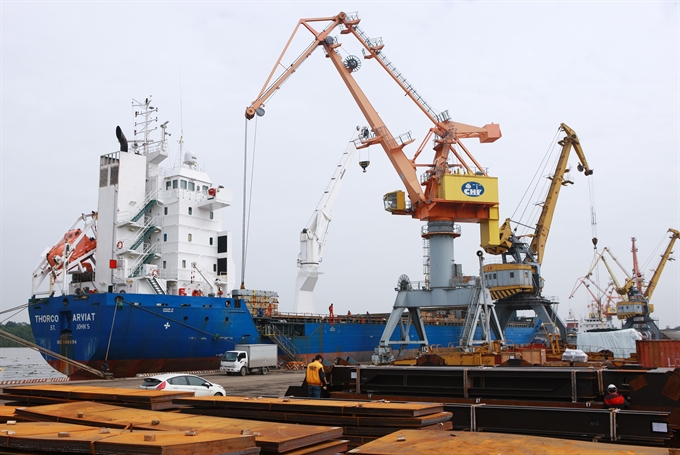 Society
Society

Hải Phòng Port in northern Hải Phòng City is targeted to become the national-level seaport and the international gate of the north for an estimated goods of 109-114 million tonnes in and out and about 25,800 arrivals of foreign tourists by 2020.
 |
| Goods are unloaded at Hải Phòng Port. The port in northern Hải Phòng City is targeted to become the national-level seaport and the international gate of the north for an estimated goods of 109-114 million tonnes in and out and about 25,800 arrivals of foreign tourists by 2020.— VNA/VNS Photo Lâm Khánh |
HÀ NỘI — The northern port city of Hải Phòng is expected to become the international gate of the north for an estimated 109-114 million tonnes of goods in and out and about 25,800 foreign tourists by 2020.
The goal was set under the planning for seaports in the north by 2020 with a vision towards 2030, recently approved by Minister of Transport Trương Quang Nghĩa.
The main terminals of Hải Phòng seaport include Sông Cấm, Đình Vũ, Lạch Huyện, Nam Đồ Sơn, and Bạch Long Vĩ.
By 2020, Sông Cấm Terminal will receive cargo vessels with loading capacity of 5,000-10,000 tonnes, Đình Vũ Terminal will receive cargo vessels with loading capacity of over 20,000 tonnes from nearby countries, Lạch Huyện Terminal will receive vessels carrying up to 6,000 foreign passengers, Nam Đồ Sơn Terminal will be used for national security and defense; and Bạch Long Vĩ Terminal, connecting the Bạch Long Vĩ Island with the mainland, will be used to boost the island’s development.
The plan also includes the development of Quảng Ninh, Thái Bình and Hải Thịnh seaports in the next four years.
Quảng Ninh Port, a national-level port, with main terminals of Cái Lân, Hòn Gai, Cẩm Phả, Yên Hưng, Hải Hà, Vạn Gia, Mũi Chùa, Vân Đồn, Vạn Hoa and Cô Tô, is expected to handle 65.5-75.5 million tones of goods in and out by 2020, and 121-142.5 million tonnes by 2030. Foreign tourist arrivals are set to hit 252,500 by 2020 and 723,200-823,200 yearly by 2030.
Thái Bình Port will be a provincial-level seaport, with Diêm Điền and Trà Lý terminals. It is expected to receive 2 million tonnes of goods by 2020 and 6.25 million tonnes by 2030.
Lastly, Hải Thịnh Port, based in Nam Định Province, also a provincial-level seaport, will transport goods to and from the Nam Định Thermal Power Plant. The port is set to receive 500,000 tonnes of goods by 2020, and 6.25 million tonnes by 2030.
How to implement
To reach the goals, Minister Nghĩa ordered agencies to enhance public-private partnerships and create favourable conditions for investment.
Simplifying administrative procedures in investing activities should be implemented also, he said.
Nghĩa assigned the Việt Nam Maritime Administration to work with local authorities to run the planning and report to the ministry.
Heads of People’s Committees in the four localities were told to allocate land funds for developing seaports, he said.
The planning of seaports in the north by 2020 with vision towards 2030, was issued to better serve sea transport demands in the triangle of economic zones of Hà Nội, Hải Phòng and Quảng Ninh.
It also aimed to develop northern seaports and boost socio-economic development in the north region by 2020, the ministry said. — VNS




